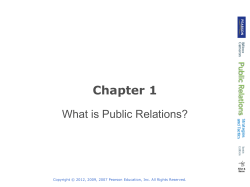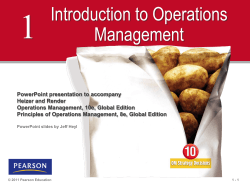
WHAT IS MONEY? Chapter 3 The Economics of Money, Banking,
Mishkin/Serletis The Economics of Money, Banking, and Financial Markets Fifth Canadian Edition Chapter 3 WHAT IS MONEY? Copyright © 2014 Pearson Canada Inc. Learning Objectives 1. Describe the meaning of the word money 2. Distinguish among the three primary functions of money 3. Illustrate how information technology has paved the way for e-money, e-banking, and e-commerce 4. Explain money measurement matters Copyright © 2014 Pearson Canada Inc. 3-2 Meaning of Money • What is it? • Money (or the “money supply”): anything that is generally accepted in payment for goods or services or in the repayment of debts. • A broad definition Copyright © 2014 Pearson Canada Inc. 3-3 Meaning of Money (cont’d) • Money (a stock concept) is different from: – Wealth • the total collection of pieces of property that serve to store value – Income • flow of earnings per unit of time • a flow concept Copyright © 2014 Pearson Canada Inc. 3-4 Functions of Money: Medium of Exchange • Medium of Exchange: – eliminates the trouble of finding a double coincidence of needs (reduces transaction costs) – promotes specialization • A medium of exchange must – – – – – be easily standardized be widely accepted be divisible be easy to carry not deteriorate quickly Copyright © 2014 Pearson Canada Inc. 3-5 Functions of Money: Unit of Account • Unit of Account: – used to measure value in the economy – reduces transaction costs Copyright © 2014 Pearson Canada Inc. 3-6 Functions of Money: Store of Value • Store of Value: – used to save purchasing power over time. – other assets also serve this function – money is the most liquid of all assets but loses value during inflation – hyperinflation is when the inflation rate exceeds 50% per month Copyright © 2014 Pearson Canada Inc. 3-7 Evolution of the Payments System • Commodity Money – valuable, easily standardized and divisible commodities – e.g. precious metals, cigarettes • Fiat Money – paper money decreed by governments as legal tender Copyright © 2014 Pearson Canada Inc. 3-8 Evolution of the Payments System (cont’d) • Cheques – an instruction to your bank to transfer money from your account • Electronic Payment – e.g. online bill pay • E-Money (electronic money): – debit card – stored-value card (smart card) – e-cash Copyright © 2014 Pearson Canada Inc. 3-9 FYI Are We Headed for a Cashless Society? • Predictions of a cashless society have been around for decades • E-money might be more convenient and efficient than a payments system based on paper • Several factors work against the disappearance of the paper system • The use of e-money will likely still increase in the future Copyright © 2014 Pearson Canada Inc. 3-10 Measuring Money • How do we measure money? Which particular assets can be called “money”? • Construct monetary aggregates using the concept of liquidity • M1+ – the narrowest definition is called M1+ – includes: currency in circulation + chequable deposits at chartered banks, TMLs, and CUCPs – these assets are all extremely liquid Copyright © 2014 Pearson Canada Inc. 3-11 Measuring Money (cont’d) • M2 – Currency in circulation + personal deposits at chartered banks + non-personal demand and notice deposits at chartered banks + fixed term deposits Copyright © 2014 Pearson Canada Inc. 3-12 Measures of Monetary Aggregates Copyright © 2014 Pearson Canada Inc. 3-13 Growth Rates of Monetary Aggregates • Does it matter which measure of money is considered? • Aggregates can move in different directions in the short run (see figure 3-2) • Conclusion: the choice of monetary aggregate is important for policymakers Copyright © 2014 Pearson Canada Inc. 3-14 Growth Rates of M2, M1++, M2++ Copyright © 2014 Pearson Canada Inc. 3-15 FYI: Where Are All the Dollars? • The more than $1500 of currency held per person in the Canada is a surprisingly large number • Where are all these dollars and who is holding them? – criminals – foreigners Copyright © 2014 Pearson Canada Inc. 3-16 Money as a Weighted Aggregate • The Bank of Canada’s money supply measures are ‘simple-sum’ indices, the index M = x1 + x2 + … + xn , where xj is one of the n monetary components of the monetary aggregate M • Weighted monetary aggregates seem to predict inflation and the business cycle somewhat better than the conventional measures Copyright © 2014 Pearson Canada Inc. 3-17 How Reliable are the Money Data? • Revisions are issued because: – small depository institutions report infrequently – adjustments must be made for seasonal variation • We probably should not pay much attention to shortrun movements in the money supply numbers but should be concerned only with longer-run movements Copyright © 2014 Pearson Canada Inc. 3-18
© Copyright 2025





















